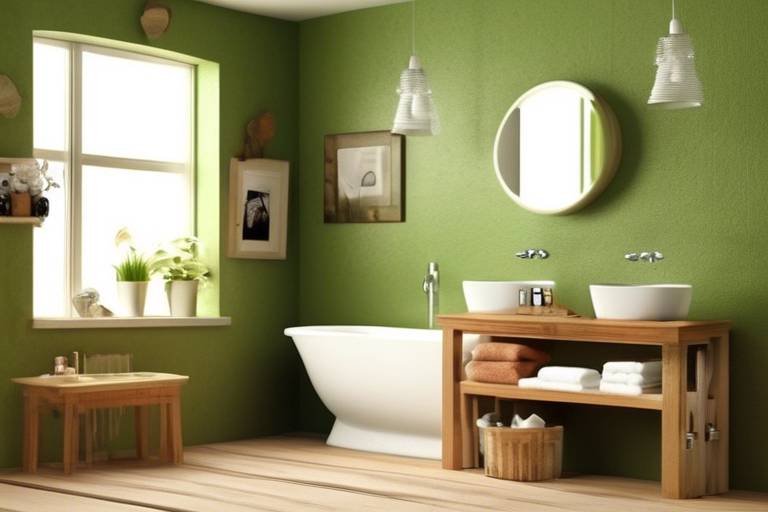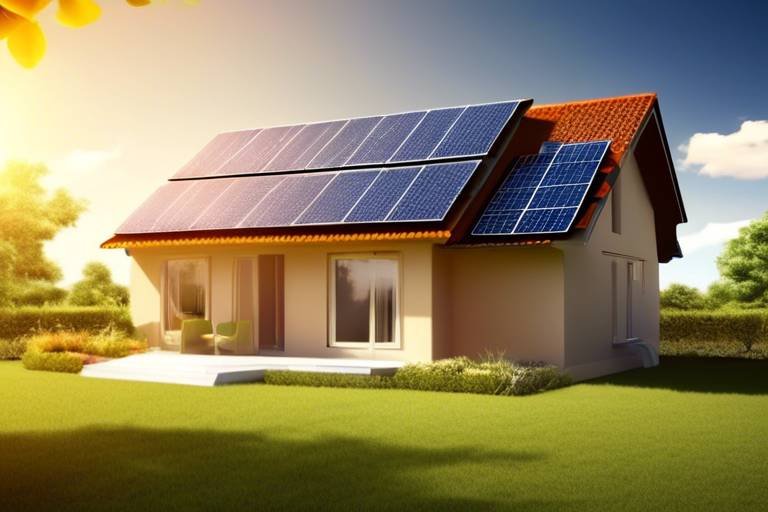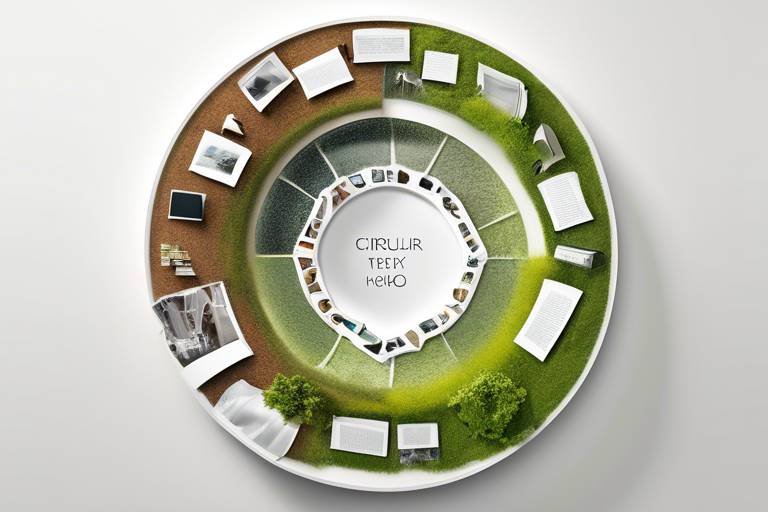DIY Tips for Creating an Eco-Friendly Bathroom
Transforming your bathroom into an eco-friendly haven is not just a trend; it’s a necessity for our planet. In today’s world, where environmental concerns are at an all-time high, taking steps to create a sustainable space in your home can make a significant difference. Imagine stepping into a bathroom that not only looks good but also feels good to use because you know it’s contributing to a healthier planet. This article provides practical tips and ideas for transforming your bathroom into an eco-friendly space. Discover sustainable materials, water-saving fixtures, and green cleaning solutions to enhance your bathroom's environmental impact.
When it comes to bathroom renovations, selecting the right materials can set the tone for your eco-friendly journey. Think about materials that are not only sustainable but also bring a unique aesthetic to your space. For example, bamboo is a fantastic choice; it’s a fast-growing grass that can be harvested without harming the environment. Imagine a sleek bamboo vanity that adds warmth and style to your bathroom! Another great option is reclaimed wood, which gives your space character while reducing the demand for new lumber. Plus, recycled tiles can add a pop of color and personality, all while being gentle on the earth. By choosing these materials, you’re not just renovating; you’re making a statement about sustainability.
One of the most effective ways to make your bathroom eco-friendly is by installing water-saving fixtures. These innovative products can significantly reduce your water consumption without compromising on performance. For instance, low-flow toilets and efficient showerheads are must-haves in any green bathroom. Imagine being able to enjoy a long, relaxing shower while knowing that you’re using less water. It’s a win-win situation! Not only do these upgrades contribute to sustainability, but they also save you money on your water bill in the long run.
Let’s dive deeper into low-flow toilets. These fixtures are designed to use significantly less water per flush compared to traditional models. You might be wondering, “How much water can I really save?” Well, many low-flow toilets use as little as 1.28 gallons per flush, compared to the usual 3.5 gallons of older models. This eco-friendly choice can lead to substantial water savings over time, making it a smart investment for your home. Think about it: every flush counts!
When considering low-flow toilets, you’ll find a variety of options available. Each type offers unique advantages for water conservation and waste management. Here are a few to consider:
- Dual-Flush Toilets: These toilets offer two flushing options: one for liquid waste and another for solid waste, allowing you to use less water when possible.
- Composting Toilets: Ideal for off-grid living, these toilets break down waste without using water, making them a truly sustainable option.
Installing a low-flow toilet is easier than you might think! Here are some practical tips to ensure optimal performance:
- Always check for leaks after installation.
- Follow the manufacturer’s guidelines for setting the water level.
- If unsure, consider hiring a professional plumber to guarantee a proper installation.
Next up, let’s talk about efficient showerheads. These fixtures are designed to maintain pressure while using less water, ensuring that you still enjoy a refreshing shower experience. Imagine stepping into a shower that feels just as luxurious but uses only a fraction of the water! By replacing your old showerhead with a water-efficient model, you can save gallons of water each time you shower. It’s an easy upgrade that makes a big impact!
Now that you’ve made some fantastic upgrades, keeping your eco-friendly bathroom clean is essential. Switching to eco-friendly cleaning products is a no-brainer. Not only are they effective, but they’re also safe for both your family and the environment. Think about all the harsh chemicals found in traditional cleaners; switching to natural alternatives can significantly reduce your chemical exposure.
Creating your own cleaning solutions is simpler than you might think! You can use common household ingredients like vinegar and baking soda to whip up effective cleaners. For instance, a mixture of vinegar and water can work wonders on glass surfaces, leaving them streak-free and sparkling. Plus, these homemade solutions are cost-effective and allow you to control what goes into your cleaning products.
If DIY isn’t your style, consider exploring brands that prioritize sustainability in their cleaning products. Supporting these companies helps promote environmentally responsible practices and reduces harmful chemicals in your home. Look for labels that indicate biodegradable ingredients or recyclable packaging. Your choice matters!
Q: How can I make my bathroom more eco-friendly without a full renovation?
A: Start by replacing your cleaning products with eco-friendly options, installing water-saving fixtures, and using sustainable materials for any minor updates.
Q: Are low-flow toilets really effective?
A: Absolutely! They can save a significant amount of water without sacrificing performance, making them a smart choice for sustainability.
Q: What are some easy homemade cleaning solutions?
A: You can create effective cleaners using vinegar, baking soda, and essential oils. For example, a mixture of vinegar and water can clean mirrors and windows effectively.

Choosing Sustainable Materials
When it comes to creating an eco-friendly bathroom, one of the most impactful changes you can make is to choose sustainable materials. Not only do these materials help to reduce your environmental footprint, but they also add a unique touch to your space. Imagine stepping into a bathroom that feels both luxurious and natural, where every element has been thoughtfully selected to be kind to our planet. It’s like bringing a piece of nature into your home!
Let’s dive into some fantastic sustainable options that you can consider for your bathroom renovation:
- Bamboo: This fast-growing grass is a superstar in the world of sustainable materials. It’s incredibly durable, water-resistant, and adds a warm, inviting feel to your bathroom. Whether you choose bamboo for your flooring, cabinetry, or even accessories, it’s a choice that screams eco-friendliness.
- Reclaimed Wood: Imagine using wood that has a story to tell! Reclaimed wood is salvaged from old buildings, barns, or furniture, giving it a second life. Not only does it reduce waste, but it also brings a rustic charm to your bathroom. Think of a beautiful reclaimed wood vanity that becomes the centerpiece of your space.
- Recycled Tiles: Tiles made from recycled materials such as glass or ceramic can add a stunning visual element to your bathroom. They come in various colors and patterns, allowing you to express your style while being environmentally responsible. Plus, they require less energy to produce compared to new tiles.
Incorporating these materials not only enhances the aesthetic appeal of your bathroom but also contributes to a healthier environment. Each choice you make can lead to a ripple effect of sustainability. It’s like planting a seed; with each eco-friendly decision, you’re nurturing a greener future.
If you're worried about the costs associated with sustainable materials, fear not! Many eco-friendly options are becoming increasingly affordable as more manufacturers embrace green practices. Plus, the long-term savings on energy and water bills can offset initial investments. Think of it as a win-win situation!
Now, let’s talk about the importance of sourcing these materials responsibly. Always look for certifications or labels that indicate sustainability, such as FSC (Forest Stewardship Council) for wood products or GreenGuard for low-emission materials. This ensures that what you’re buying not only looks good but is also good for the planet.
In conclusion, choosing sustainable materials is a crucial step in transforming your bathroom into an eco-friendly oasis. It’s about making conscious decisions that reflect your values while creating a space that you can be proud of. So, why not start today? Your bathroom—and the Earth—will thank you!

Water-Saving Fixtures
When it comes to creating an eco-friendly bathroom, one of the most impactful changes you can make is to install . These innovative products not only help you conserve water but also lower your utility bills, making them a win-win for both your wallet and the environment. Imagine taking a long, relaxing shower, feeling the warm water cascade over you, all while knowing you're using significantly less water than before. Sounds great, right? Let's dive into some of the most effective water-saving fixtures that can transform your bathroom.
First up, we have low-flow toilets. Traditional toilets can use up to 3.5 gallons of water per flush, which adds up quickly. In contrast, low-flow toilets typically use only 1.6 gallons or less. This reduction can lead to substantial water savings over time. For a family of four, switching to low-flow toilets can save an estimated 20,000 gallons of water per year! It's like having a money-saving superhero right in your bathroom.
Now, you might be wondering about the different types of low-flow toilets available. There are primarily two types: dual-flush toilets and composting toilets. Dual-flush toilets offer two flush options: a lower volume for liquid waste and a higher volume for solid waste. This flexibility allows users to choose the appropriate flush, maximizing water efficiency. Composting toilets, on the other hand, don’t use water for flushing at all. Instead, they break down waste using aerobic bacteria, making them an excellent choice for off-grid living or eco-conscious homeowners.
| Type | Water Usage | Advantages |
|---|---|---|
| Dual-Flush | 1.1 - 1.6 gallons per flush | Flexible flushing options, significant water savings |
| Composting | No water usage | Eco-friendly, reduces sewage waste |
Installing a low-flow toilet may seem daunting, but it’s quite manageable with the right approach. Here are some practical tips to ensure a successful installation:
- Turn off the water supply and empty the existing toilet before removal.
- Follow the manufacturer's instructions closely for installation.
- Use a level to ensure the toilet is installed evenly.
- Check for leaks after installation by observing the connections for a few hours.
Next, we have efficient showerheads. These fixtures are designed to deliver a satisfying shower experience while using significantly less water. Traditional showerheads can use up to 2.5 gallons of water per minute, but efficient models can cut that down to about 1.5 gallons per minute without sacrificing water pressure. It's like having your cake and eating it too—enjoying a refreshing shower while being kind to the planet!
When choosing an efficient showerhead, look for models that are labeled as WaterSense certified. This certification means that the product meets the EPA's criteria for water efficiency without compromising performance. With a variety of styles and designs available, you can easily find a showerhead that complements your bathroom decor while helping you save water.
In conclusion, upgrading to water-saving fixtures is a crucial step in creating an eco-friendly bathroom. Not only do these fixtures help conserve our precious water resources, but they also provide financial savings over time. By making simple changes like installing low-flow toilets and efficient showerheads, you can significantly reduce your environmental footprint while enjoying a functional and stylish bathroom.
Q: How much water can I save by switching to low-flow toilets?
A: On average, a family of four can save about 20,000 gallons of water per year by switching to low-flow toilets.
Q: Are low-flow toilets more expensive than traditional toilets?
A: While low-flow toilets may have a higher upfront cost, the long-term savings on water bills can offset this initial investment.
Q: Can I install low-flow fixtures myself?
A: Yes! Many homeowners can install low-flow toilets and showerheads with basic tools and some DIY knowledge. Just be sure to follow the manufacturer’s instructions.
Q: What is a WaterSense certified product?
A: WaterSense is a label from the EPA that identifies water-efficient products that perform well and help save water.

Low-Flow Toilets
When it comes to making your bathroom more eco-friendly, are an absolute game changer. These innovative fixtures are designed to use significantly less water per flush than traditional toilets, which can lead to impressive water savings over time. Imagine reducing your water bill while also doing your part for the environment—sounds like a win-win, right? With the average toilet accounting for nearly 30% of household water use, switching to a low-flow model can make a substantial difference.
But how do low-flow toilets actually work? Well, they utilize advanced flushing technology that maximizes the force of the water while minimizing the amount used. For instance, many low-flow toilets operate on just 1.28 gallons per flush (GPF), compared to the standard 1.6 GPF of older models. This reduction might seem small, but when you multiply it over the course of a year, the savings can be significant. Plus, many modern designs are sleek and stylish, so you won’t have to sacrifice aesthetics for sustainability.
Now, let’s talk about the different types of low-flow toilets available. You might be surprised to learn that there are several options to choose from:
- Dual-Flush Toilets: These toilets offer two flush options—one for liquid waste and another for solid waste. This feature allows you to choose a lower volume flush when possible, further conserving water.
- Composting Toilets: These are a fantastic option for those looking to go off-grid or minimize their water use even further. Composting toilets break down waste naturally without using water, making them incredibly eco-friendly.
Choosing the right type for your home can depend on a variety of factors, including the size of your household, your plumbing setup, and personal preferences. Regardless of the model you select, the key takeaway is that low-flow toilets can drastically reduce your water consumption without compromising performance.
Before making the switch, consider the installation process. While many homeowners might feel intimidated by the idea of installing a new toilet, it’s often a straightforward DIY project. Here are some quick tips to ensure a successful installation:
- Always turn off the water supply before beginning any plumbing work.
- Carefully follow the manufacturer's instructions for installation.
- Make sure to check for leaks after installation and adjust as necessary.
In conclusion, investing in a low-flow toilet is not just a smart financial decision; it’s also a step toward a more sustainable lifestyle. With their modern designs, efficiency, and the potential for significant water savings, low-flow toilets are a must-have for anyone looking to enhance their eco-friendly bathroom. So why wait? Make the switch today and enjoy the benefits of a greener home!
Q: Will I notice a difference in flushing power with a low-flow toilet?
A: Not at all! Modern low-flow toilets are designed with advanced flushing technology that ensures powerful performance while using less water.
Q: Are low-flow toilets more expensive than traditional ones?
A: While they may have a higher upfront cost, the savings on your water bill over time can make them a cost-effective choice in the long run.
Q: Can I install a low-flow toilet myself?
A: Yes, many homeowners find the installation process manageable with a few basic tools and the right instructions. However, if you're unsure, hiring a professional is always a good option.

Types of Low-Flow Toilets
When it comes to embracing sustainability in your bathroom, low-flow toilets are a game changer. They not only help conserve water but also come in various types, each designed to meet different needs and preferences. Understanding these types can assist you in making an informed choice that aligns with your eco-friendly goals.
One popular type is the dual-flush toilet. This innovative design features two buttons: one for liquid waste and another for solid waste. By offering a choice, dual-flush toilets can use as little as 0.8 gallons for a light flush and up to 1.6 gallons for a full flush. This flexibility can lead to significant water savings over time, especially in households with heavy usage.
Another interesting option is the composting toilet. This type is particularly appealing for those looking to go off the grid or reduce their environmental footprint dramatically. Composting toilets use no water at all, relying instead on a natural decomposition process to break down waste. While they may require a bit more maintenance, the benefits of turning waste into compost can be quite rewarding, not to mention the massive water savings!
For those who prefer a more traditional look, gravity-flush toilets are a reliable choice. These toilets use the natural force of gravity to flush waste away, typically using 1.6 gallons per flush. While they are not as water-efficient as dual-flush or composting models, they still represent a significant reduction in water usage compared to older toilet models that can use up to 7 gallons per flush.
Lastly, there are pressure-assisted toilets, which utilize compressed air to forcefully expel waste. These toilets are known for their powerful flush, which can be beneficial in households with multiple users. While they may use a bit more water than gravity-flush models, their efficiency in waste removal can lead to less frequent clogs, ultimately saving water in the long run.
Here's a quick comparison of the different types of low-flow toilets:
| Type | Water Usage | Key Features |
|---|---|---|
| Dual-Flush Toilet | 0.8 - 1.6 gallons | Two flush options for different waste types |
| Composting Toilet | No water usage | Turns waste into compost; eco-friendly |
| Gravity-Flush Toilet | 1.6 gallons | Simple design; reliable flushing |
| Pressure-Assisted Toilet | 1.6 gallons | Powerful flush; reduces clogs |
Choosing the right type of low-flow toilet for your bathroom can make a significant difference in your water consumption and environmental impact. Whether you opt for a dual-flush model for its versatility or a composting toilet for its zero-water usage, each choice contributes to a more sustainable future. Remember, every drop counts!
- How much water can I save by switching to a low-flow toilet? Switching to a low-flow toilet can save a household thousands of gallons of water each year, depending on usage.
- Are low-flow toilets more expensive? While the initial cost may be higher, the long-term savings on water bills can offset this expense.
- Do low-flow toilets flush as well as traditional toilets? Yes, modern low-flow toilets are designed to flush effectively, often using advanced technology to ensure waste is removed efficiently.

Installation Tips
Installing a low-flow toilet can seem daunting, but with a little guidance, you can turn this eco-friendly upgrade into a rewarding DIY project. First and foremost, it’s crucial to gather all the necessary tools before you start. You’ll need a wrench, a screwdriver, a level, and some plumber's tape. Having everything on hand will save you from unnecessary trips to the hardware store mid-installation!
Next, you should turn off the water supply to your existing toilet. This is usually done by locating the shut-off valve behind the toilet. Once the water is off, flush the toilet to empty the tank, and then use a sponge to soak up any remaining water in the bowl and tank. This step is vital to avoid a messy situation when you disconnect the old toilet.
Now, it’s time to remove the old toilet. Start by unscrewing the bolts at the base of the toilet, which you can usually find under plastic caps. After that, gently rock the toilet back and forth to break the seal and lift it off the flange. Be careful, as toilets can be heavy and awkward to maneuver. It’s a good idea to have someone assist you with this part to avoid any accidents.
Once the old toilet is removed, it’s essential to inspect the flange for any damage. If it’s cracked or broken, you’ll need to replace it before installing your new low-flow toilet. After confirming that the flange is in good shape, you can install a new wax ring on the flange. This ring creates a watertight seal, preventing leaks.
Now comes the fun part—installing your new low-flow toilet! Carefully place the toilet over the flange, aligning the holes with the bolts. Once it’s positioned correctly, press down firmly to set the wax ring and secure the toilet with the nuts provided. Make sure to use a level to check that the toilet is sitting evenly; an uneven toilet can lead to future issues.
After securing the toilet, reconnect the water supply line and turn the water back on. It’s important to check for leaks at this stage. Flush the toilet a few times, watching closely for any signs of water seeping from the base or around the connections. If everything is dry, congratulations—you’ve successfully installed your low-flow toilet!
Finally, don’t forget to dispose of your old toilet responsibly. Many local waste management services offer recycling programs for old toilets, which can help keep them out of landfills. By following these installation tips, you not only enhance your bathroom’s eco-friendliness but also gain a sense of accomplishment in your DIY skills!
Here are some common questions people have about installing low-flow toilets:
- How much water does a low-flow toilet save? Low-flow toilets typically use about 1.6 gallons per flush, compared to older models that can use up to 7 gallons. This can lead to significant water savings over time.
- Can I install a low-flow toilet myself? Yes! With the right tools and some careful steps, many homeowners can successfully install a low-flow toilet on their own.
- What if my toilet doesn’t flush properly after installation? If you experience flushing issues, check to ensure that the water supply is fully open and that the toilet is level. If problems persist, consult the installation manual or a plumbing professional.

Efficient Showerheads
When it comes to transforming your bathroom into an eco-friendly haven, are a game changer. These innovative fixtures are designed to minimize water usage without compromising on the quality of your shower experience. Imagine stepping into a shower that feels just as invigorating as a traditional one, yet uses significantly less water. Sounds appealing, right? Well, that's the beauty of efficient showerheads!
One of the most exciting aspects of modern showerheads is their advanced technology. Many efficient models utilize aeration, which mixes air with water to create a fuller spray while using less liquid overall. This means you can enjoy a luxurious shower while being kind to the planet. Additionally, these fixtures often come with adjustable settings, allowing you to customize your shower experience according to your mood—whether you want a gentle mist or a powerful massage.
But how much water can you actually save? Let's break it down:
| Type of Showerhead | Water Usage (gallons per minute) | Annual Water Savings (gallons) |
|---|---|---|
| Traditional Showerhead | 2.5 | 1,500 |
| Low-Flow Showerhead | 1.5 | 900 |
| High-Efficiency Showerhead | 1.0 | 600 |
As you can see from the table above, switching from a traditional showerhead to a low-flow or high-efficiency model can lead to substantial annual water savings. Just think about what you could do with all that extra water saved—maybe a few extra plants in your garden or even a more sustainable lifestyle overall!
Installing an efficient showerhead is a straightforward process that most homeowners can tackle on their own. Typically, all you need is a wrench and some plumber's tape. Simply unscrew your old showerhead, wrap the threads of the new one with tape to prevent leaks, and screw it into place. Voila! You've just made a significant step toward an eco-friendly bathroom.
In summary, efficient showerheads are not just a practical addition to your eco-friendly bathroom; they are a smart investment. They save water, help you save on utility bills, and allow you to enjoy guilt-free indulgence during your daily shower routine. So why not make the switch today? Your wallet and the planet will thank you!
- What is a low-flow showerhead? A low-flow showerhead is designed to use less water than traditional models, typically using 1.5 gallons per minute or less.
- Will I notice a difference in water pressure? Most efficient showerheads are designed to maintain water pressure while reducing flow, so you shouldn't notice a significant difference.
- Can I install a new showerhead myself? Yes! Installing a new showerhead is a simple DIY project that requires minimal tools.
- How can I ensure my showerhead is eco-friendly? Look for models that are WaterSense certified, which means they meet EPA criteria for water efficiency.

Eco-Friendly Cleaning Products
Switching to is essential for maintaining a sustainable bathroom. Not only do these products help protect our planet, but they also ensure a healthier environment for you and your family. Traditional cleaning products often contain harsh chemicals that can be harmful to both your health and the ecosystem. By choosing green alternatives, you're making a conscious decision to reduce your carbon footprint while still achieving a sparkling clean space.
When it comes to eco-friendly cleaning solutions, there are numerous options available that are both effective and safe. For instance, many brands now offer biodegradable or plant-based cleaning agents that can tackle tough stains without the toxic aftereffects. You might be surprised to learn that some of the most effective cleaning agents can be found right in your kitchen cupboard! Natural ingredients like vinegar, baking soda, and lemon juice can be combined to create powerful cleaning solutions that not only clean but also disinfect.
For those who prefer to buy ready-made products, there are many brands that prioritize sustainability in their cleaning offerings. These companies often use recycled packaging and source ingredients responsibly. By supporting these brands, you're not just cleaning your bathroom; you're also contributing to a larger movement towards environmental responsibility. Here’s a quick comparison of some popular eco-friendly brands:
| Brand | Key Features | Certifications |
|---|---|---|
| Seventh Generation | Plant-based ingredients, biodegradable packaging | EPA Safer Choice |
| Method | Non-toxic, stylish packaging, cruelty-free | Leaping Bunny |
| Mrs. Meyer's Clean Day | Essential oils, garden-inspired scents | USDA Certified Biobased |
Another great way to ensure your cleaning routine is eco-friendly is by creating your own homemade cleaning solutions. Not only are these options cost-effective, but they also allow you to control the ingredients that go into your products. For example, a simple mixture of vinegar and water can effectively clean mirrors and windows, leaving them streak-free. Baking soda can be used to scrub surfaces, while lemon juice serves as a natural disinfectant. The versatility of these natural ingredients means you can tackle virtually any cleaning task without resorting to harmful chemicals.
In conclusion, making the switch to eco-friendly cleaning products is a small change that can lead to significant benefits for both your home and the environment. By opting for natural alternatives or supporting sustainable brands, you are taking a step towards a cleaner, healthier bathroom and planet. So next time you reach for that cleaning spray, think about the impact it has on your health and the world around you. Choose wisely, and let your bathroom reflect your commitment to sustainability!
- What are eco-friendly cleaning products? Eco-friendly cleaning products are made from natural ingredients that are safe for the environment and human health. They typically avoid harsh chemicals found in conventional cleaners.
- Are homemade cleaning solutions effective? Yes! Many homemade cleaning solutions using ingredients like vinegar, baking soda, and lemon juice are highly effective for cleaning various surfaces.
- How can I ensure the cleaning products I buy are eco-friendly? Look for certifications such as EPA Safer Choice or USDA Certified Biobased, and check the ingredient list for natural components.

Homemade Cleaning Solutions
This article provides practical tips and ideas for transforming your bathroom into an eco-friendly space. Discover sustainable materials, water-saving fixtures, and green cleaning solutions to enhance your bathroom's environmental impact.
Explore various eco-friendly materials for your bathroom renovation, including bamboo, reclaimed wood, and recycled tiles. These options not only reduce environmental impact but also add unique aesthetics to your space.
Learn about innovative water-saving fixtures that can significantly reduce your water consumption. From low-flow toilets to efficient showerheads, these upgrades contribute to sustainability while maintaining functionality.
Discover the benefits of installing low-flow toilets, which use significantly less water per flush compared to traditional models. This eco-friendly choice can lead to substantial water savings over time.
Explore the different types of low-flow toilets available, including dual-flush and composting models. Each type offers unique advantages for water conservation and waste management.
Get practical advice on how to install low-flow toilets effectively. Proper installation ensures optimal performance and maximizes water-saving benefits in your eco-friendly bathroom.
Find out how efficient showerheads can help conserve water without sacrificing your shower experience. These fixtures are designed to maintain pressure while using less water.
Switching to eco-friendly cleaning products is essential for maintaining a sustainable bathroom. Learn about natural alternatives that are effective and safe for both your family and the environment.
If you're looking to keep your bathroom sparkling clean while also being kind to the planet, are your best bet! Not only are they easy to make, but they also use ingredients that are often found in your pantry. Think about it: why spend money on expensive, chemical-laden cleaners when you can whip up an effective solution at home? For instance, a simple mix of vinegar and baking soda can tackle tough stains and eliminate odors without harming the environment.
Here are a few recipes to get you started:
- All-Purpose Cleaner: Combine equal parts of water and white vinegar in a spray bottle. This solution is perfect for countertops, mirrors, and even bathroom tiles!
- Scrubbing Paste: Mix baking soda with a little water to create a paste. This is great for scrubbing sinks and tubs, leaving them shiny and fresh.
- Glass Cleaner: Mix 1 cup of water, 1 cup of vinegar, and a few drops of dish soap. Spray on glass surfaces for a streak-free shine!
Using these homemade solutions not only reduces your exposure to harsh chemicals but also minimizes plastic waste from store-bought products. Plus, you can customize scents by adding essential oils like lemon or lavender. It's a win-win situation!
Q: Are homemade cleaning solutions really effective?
A: Absolutely! Many homemade cleaning solutions are just as effective as commercial products, and they often contain fewer harmful chemicals.
Q: Will these solutions harm my plumbing?
A: No, most homemade cleaning solutions are safe for plumbing. However, always avoid using too much vinegar on natural stone surfaces, as it can cause damage over time.
Q: Can I use essential oils in my cleaning solutions?
A: Yes! Essential oils not only add pleasant scents but also have natural antibacterial properties, making them a great addition to your cleaning routine.

Choosing Green Brands
When it comes to creating an eco-friendly bathroom, one of the most impactful decisions you can make is to choose green brands for your cleaning products. But what exactly does it mean to be a green brand? In essence, these companies prioritize sustainability in their production processes, sourcing ingredients that are not only effective but also safe for the environment and your health. By supporting these brands, you're not just purchasing a product; you're endorsing a philosophy of responsibility and care for our planet.
Many green brands focus on using natural ingredients that are biodegradable and free from harmful chemicals. This is crucial because traditional cleaning products often contain toxic substances that can pollute our waterways and harm aquatic life. Plus, using eco-friendly products in your bathroom reduces your family’s exposure to potentially harmful chemicals. So, how do you identify these green brands in a sea of options? Here are a few tips:
- Look for Certifications: Certifications like Green Seal or EPA Safer Choice indicate that a product meets strict environmental standards.
- Read the Labels: Check the ingredient list for natural components and avoid products with long lists of unrecognizable chemicals.
- Research Brand Values: Visit the brand’s website to learn about their sustainability practices and commitment to eco-friendly initiatives.
Some popular green brands that have gained recognition for their commitment to sustainability include Seventh Generation, Method, and Mrs. Meyer's Clean Day. These companies not only offer effective cleaning solutions but also engage in practices like using recycled materials for packaging and supporting fair trade.
Moreover, by choosing green brands, you are contributing to a larger movement toward sustainability. It’s like casting a vote for a healthier planet every time you make a purchase. You’re supporting companies that invest in renewable resources and strive to reduce their carbon footprint. This ripple effect can lead to significant changes in the industry as more consumers demand eco-friendly options.
In conclusion, selecting green brands for your bathroom cleaning products is a simple yet powerful step toward a more sustainable lifestyle. It’s about making informed choices that align with your values and contribute positively to the environment. So, the next time you're shopping for cleaning supplies, take a moment to consider the impact of your choices. Remember, every small action counts in the journey toward an eco-friendly home.
Q: What are the benefits of using eco-friendly cleaning products?
A: Eco-friendly cleaning products are safer for both the environment and your health. They reduce chemical exposure, minimize pollution, and often use biodegradable ingredients.
Q: Where can I find green cleaning brands?
A: You can find green cleaning brands in most grocery stores, health food stores, or online. Look for products with eco-certifications and read reviews to ensure quality.
Q: Are eco-friendly cleaning products as effective as traditional ones?
A: Yes! Many eco-friendly products are just as effective, if not more so, than their traditional counterparts. They often use natural ingredients that can tackle tough stains and odors.
Q: How can I make my own eco-friendly cleaning solutions?
A: You can easily make your own cleaning solutions using common household ingredients like vinegar, baking soda, and lemon juice. These ingredients are effective and non-toxic.
Frequently Asked Questions
- What are some eco-friendly materials I can use in my bathroom renovation?
When renovating your bathroom, consider using sustainable materials like bamboo, reclaimed wood, and recycled tiles. These materials not only help reduce your environmental impact but also bring a unique and stylish aesthetic to your space.
- How do low-flow toilets work and what are their benefits?
Low-flow toilets are designed to use significantly less water per flush compared to traditional models. By opting for these toilets, you can save a substantial amount of water over time, which is great for both the environment and your water bill!
- What types of low-flow toilets are available?
There are several types of low-flow toilets, including dual-flush toilets, which allow you to choose between a full or half flush, and composting toilets, which are ideal for reducing waste. Each type has its own unique benefits for water conservation and waste management.
- Can I install a low-flow toilet myself?
Yes, you can install a low-flow toilet yourself if you have some basic plumbing skills. Just make sure to follow the installation instructions carefully to ensure optimal performance and maximize your water-saving benefits!
- What are efficient showerheads and how do they save water?
Efficient showerheads are specially designed to maintain water pressure while using less water. By switching to these fixtures, you can enjoy a satisfying shower experience while conserving water, making them a smart choice for an eco-friendly bathroom.
- What are some eco-friendly cleaning products I can use?
Switching to eco-friendly cleaning products is essential for a sustainable bathroom. Look for natural alternatives that are effective and safe, or consider making your own solutions using common household ingredients like vinegar and baking soda.
- How can I make homemade cleaning solutions?
Creating homemade cleaning solutions is simple! For example, mix equal parts of vinegar and water for an all-purpose cleaner. These solutions are not only cost-effective but also reduce exposure to harmful chemicals, making your bathroom a healthier place.
- Which brands prioritize sustainability in cleaning products?
There are several brands that focus on sustainability in their cleaning products. Look for those that use natural ingredients and eco-friendly packaging. Supporting these companies helps promote environmentally responsible practices and reduces harmful chemicals in your home.



















